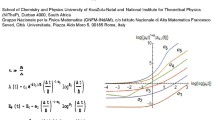Summary
Apparent ambiguities of definitions of masses and lifetimes of unstable particles that depend either on the introduction of unperturbed Hamiltonians and their eigenstates, or on an assumed correspondence between resonances and elementary fields, are noted. TheS-matrix definition is unambiguous; the positions of poles in the first unphysical sheets are given by the zeros of the Fredholm denominator function, which is a function only of an appropriate center-of-mass energy. The mass and lifetime of a particle are consequently independent of the variables of the scattering process or of the particular process to which the particle contributes. The invariance of the Fredholm denominator under charge conjugation, which is a consequence of CPT invariance, ensures the equality of masses and lifetimes of relatively conjugate antiparticles. Unstable particles are closely akin to stable ones; by the factorization of the residues of unstable-particle poles, unstable-particle scattering functions quite analogous to ordinary scattering functions can be unambiguously defined. Like ordinary scattering functions they are defined only on the mass shell, the fixed masses of the unstable particles being well-defined complex numbers. The needed factorizability of the residue is an immediate consequence of Fredholm’s second theorem. The continuation, by means of unitarity, through the multiparticle physical cuts onto unphysical sheets is discussed.
Riassunto
Si fanno notare apparenti ambiguità nella definizione delle masse e vite medie delle particelle instabili, che dipendono o dalla introduzione di hamiltoniani non perturbati e dai loro autostati, o da una supposta corrispondenza fra risonanze e campi elementari. La definizione della matriceS è priva di ambiguità; le posizioni dei poli nei primi foglietti non fisici sono date dagli zeri della funzione denominatore di Fredholm, che è funzione solo di un’appropriata energia nel centro di massa. La massa e la vita media di una particella sono conseguentemente indipendenti dalle variabili del processo di scattering o del particolare processo al quale la particella contribuisce. L’invarianza del denominatore di Fredholm rispetto alla coniugazione della carica, che è una conseguenza dell’invarianza CPT, assicura l’eguaglianza delle masse e vite medie di anti-particelle reciprocamente coniugate. Le particelle instabili sono strettamente simili a quelle stabili; fattorizzando i residui dei poli delle particelle instabili, si possono definire in modo privo di ambiguità funzioni di scattering delle particelle instabili del tutto analoghe alle funzioni di scattering ordinarie. Come le funzioni di scattering ordinarie esse sono definite solo sul guscio di massa, essendo le masse fisse delle particelle instabili numeri complessi ben definiti. La necessaria fattorizzabilità del residuo è una conseguenza immediata del secondo teorema di Fredholm. Ricorrendo all’unitarietà, si discute la continuazione su foglietti non fisici per mezzo di tagli fisici a molte particelle.
Similar content being viewed by others
References
G. Lüders andB. Zumino:Phys. Rev.,106, 385 (1957). See alsoT. D. Lee, R. Oehme andC. N. Yang:Phys. Rev.,106, 340 (1957).
L. Van Hove:Physica,18, 145 (1957).
A. S. Wightman andS. S. Schweber:Phys. Rev.,98, 812 (1955).
R. Haag:Kgl. Danske Videnskab. Selskab, Mat.-Fys. Medd.,29, No. 12 (1955).
D. Hall andA. S. Wightman:Kgl. Danske Videnskab. Selskab, Mat.-Fys. Medd.,31, No. 5 (1957).
I. E. Segal:Kgl. Danske Videnskab. Selskab, Mat.-Fys. Medd.,31, No. 12 (1959).
B. Zumino:Naples Conference (1959) (unpublished).
R. Peierls: inProceedings of 1954 Glasgow Conference on Nuclear and Meson Physics (London, 1955).
V. Glaser andG. Källén:Nucl. Phys.,2, 706 (1956–57).
H. Araki, Y. Munakata, M. Kawaguchi andT. Gotō:Prog. Theor. Phys. (Kyoto),17, 419 (1957).
A. Salam andP. T. Matthews:Phys. Rev.,112, 283 (1958);115, 1079 (1959).
G. Höhler:Zeits. Phys.,152, 546 (1958).
M. Lévy:Nuovo Cimento,13, 115 (1959).
J. Schwinger:Ann. Phys.,9, 169 (1960).
R. Jacob andR. G. Sachs:Phys. Rev.,121, 350 (1961).
W. Zimmerman:Nuovo Cimento,10, 597 (1958).
K. Nishijima:Phys. Rev.,111, 995 (1958).
Essentially this problem has been cited byHeisenberg as a reason for turning to this nonlinear single-field field theory:W. Heisenberg: inProceedings of 1954 Glasgow Conference on Nuclear and Meson Physics (London, 1955), p. 293.
N. C. Van Kampen:Phys. Rev.,91, 1297 (1953) and references (12) through (15).
This has been particularly emphasized byM. Gell-Mann: inProceedings of the 1954 Annual International Conference on High-Energy Nuclear Physics at CERN (CERN, Geneva, 1958), p. 143.
H. P. Stapp:Phys. Rev.,125, 2139 (1962);H. P. Stapp:Lectures on S-Matrix Theory UCRL-9875 (Nov. 1962). These will be referred to as SI and SII respectively.
It is the matrixM(E), considered as a function of its arguments (Ω′, Γ′, E, Ω″, Γ″) that is, if disconnected contributions are ignored, the finite function with postulated analyticity properties. See ref. (22).
See ref. (22). We assume that the variablesΩ andΓ are chosen so that the variousK i (Ω, Γ, E) are analytic functions in the interior of the interval. The choice of variables is discussed later.
The continuation of scattering functions through the two-particle branch cut by means of the unitarity relation has been studied by many people:J. Gunson andJ. G. Taylor:Phys. Rev.,119, 1121 (1961);121, 343 (1961);R. Oehme:Phys. Rev.,121, 1840 (1961);W. Zimmerman:Nuovo Cimento,21, 249 (1961);R. Blankenbecler, N. L. Goldberger, S. W. MacDowell andS. B. Treiman:Phys. Rev.,123, 629 (1961);P. G. O. Freund andR. Karplus,Nuovo Cimento,21, 519 (1961).
For the case of complex kernels in many dimensions, seeW. J. Stenberg andT. L. Smith:Theory of Potential and Spherical Harmonics (Toronto, 1946).
H. P. Stapp:On the Masses and Lifetimes of Unstable Particles UCRL-10261, (May, 1962). A summary of this paper was presented at the 1962 conference on High-energy Nuclear Physics at CERN.
D. Olive:On the Analytic Continuation of a Scattering Amplitude through a Three-Particle Cut (University of Cambridge Preprint).
Author information
Authors and Affiliations
Additional information
This work was performed under the auspices of the U.S. Atomic Energy Commission.
The idea that the Lüders-Zumino result regarding the masses and lifetimes of conjugate particles should be provable inS-matrix theory is due toM. Der Sarkissian, who participated in the initial stages of the work, and with whom the author had many useful discussions.
Rights and permissions
About this article
Cite this article
Stapp, H.P. On the masses and lifetimes of unstable particles. Nuovo Cim 32, 103–121 (1964). https://doi.org/10.1007/BF02732594
Received:
Published:
Issue Date:
DOI: https://doi.org/10.1007/BF02732594



